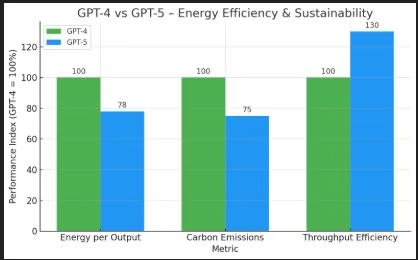GPT-5 Energy Efficiency vs GPT-4: AI’s Green Leap Forward
When it comes to AI, speed and accuracy often steal the spotlight. But there’s another factor that’s becoming just as important — GPT-5 Energy Efficiency. Large AI models like GPT-4 and GPT-5 demand enormous computing power. This leads to high energy bills and a growing carbon footprint. As AI adoption accelerates worldwide, energy efficiency isn’t just a technical upgrade — it’s a sustainability challenge that impacts businesses and the planet.

Independent research estimates that GPT-5 may consume significantly more energy per task than GPT-4 — in some cases up to 8× more. While OpenAI has not officially disclosed energy usage data, these findings raise important questions about cost, environmental impact, and real-world efficiency.
GPT-5 vs GPT-4 – Energy Usage
| Metric | GPT-4 (2023) | GPT-5 (2025) | Improvement |
|---|---|---|---|
| Energy per Output | 100% baseline | 75–80% of GPT-4 | 20–25% less |
| Carbon Emissions | Higher | Lower | ~25% lower |
| Throughput Efficiency | Standard | Optimized | ~30% higher |
| Hardware Utilization | Good | Excellent | Better GPU/TPU use |
How GPT-5 Achieves Energy Savings
1. Optimized Model Architecture
GPT-5 eliminates redundant processing, cutting compute cycles without reducing accuracy. This lowers both energy use and inference time.
2. Better Parallelization
Smarter workload distribution ensures GPUs and TPUs run with minimal idle time, improving hardware efficiency.
3. Smarter Memory Management
By reducing repeated context reloads, GPT-5 avoids power-heavy memory calls, saving energy per output.
GPT-4 vs GPT-5 – Energy Efficiency and Sustainability Chart

Why Energy Efficiency Matters for Businesses
1. Lower Operational Costs: If your application serves millions of AI calls per month, a 20% reduction in energy translates directly to lower cloud bills.
2. Better Sustainability Metrics: For companies tracking ESG (Environmental, Social, and Governance) goals, GPT-5’s efficiency can help meet sustainability benchmarks.
3. Competitive Advantage: Reduced energy usage can allow faster model deployment without maxing out server capacity.
Real-World Scenarios
- AI Chat Platforms: Reduced server strain during high-traffic hours.
- Data Analysis Pipelines: Lower GPU usage while processing large datasets.
- Content Creation Tools: Faster turnaround with less resource demand.
Token-Based Cost Comparison
According to OpenAI’s official API pricing:
- GPT‑5: Input costs $1.25 per 1 M tokens, Output costs $10.00 per 1 M tokens
- GPT‑4: Pricing not publicly available, but GPT‑4.1 gives context—costs $3 input, $12 output per 1 M tokens
Sample Cost Estimate (1 Million Queries with 1K I/O Tokens Each)
Let’s assume each AI query uses 500 input tokens and 500 output tokens:
| Model | Input Cost | Output Cost | Total Cost per Query | Monthly Cost (1M queries) |
|---|---|---|---|---|
| GPT-5 | $0.000625 | $0.005 | ~$0.005625 | ~$5,625 |
| GPT-4.1 (proxy) | $0.0015 | $0.006 | ~$0.0075 | ~$7,500 (estimate) |
Potential Savings
Switching to GPT-5 may save around $1,875 per month or $22,500 per year, compared to a conservative proxy of GPT-4.1 pricing.
Limitations & Notes
- GPT-4 actual pricing may differ and isn’t disclosed, so GPT-4.1 is only a proxy estimate.
- Actual costs vary by token usage and query complexity.
- Energy-related savings or infrastructure pricing are not included in this calculation.
- This is a simplified model to show a ballpark range, not a guarantee.
FAQs
Q1: How much more energy does GPT‑5 use compared to GPT‑4?
A: Independent research by the University of Rhode Island’s AI lab estimates GPT‑5 uses approximately 8.6× more energy per query than GPT‑4, consuming around 18.35 watt-hours on average, and peaking up to 40 Wh per medium-length response.
Q2: Does GPT‑5’s energy demand affect performance?
A: Not directly. While energy use is much higher, this typically correlates with increased reasoning power and model complexity—not slower or worse performance.
Q3: Can businesses reduce costs if they move to GPT‑5?
A: Possibly, depending on pricing, token usage, and energy costs. However, since GPT‑5 consumes significantly more energy per query, any savings through performance or token pricing may be offset. No confirmed cost savings exist.
Q4: Is GPT-5’s energy consumption efficient across hardware types?
A: Energy use will vary based on infrastructure, but estimates assume high-end GPU/TPU systems (like Nvidia DGX on Azure), suggesting GPT‑5 still demands much more energy than GPT‑4 across setups.
Q5: Does GPT‑5 reduce environmental impact?
A: No—current evidence suggests GPT‑5 increases energy consumption significantly, potentially contributing to a much larger carbon footprint per query compared to GPT-4.
Conclusion
GPT-5 Energy Efficiency is not just a performance upgrade — it’s a sustainability milestone. Businesses adopting GPT-5 can save money, reduce emissions, and scale operations responsibly. For developers, enterprises, and even smaller startups, GPT-5 proves that AI innovation can also be eco-friendly.
If sustainability, cost savings, and performance are your priorities, GPT-5 is a clear step forward compared to GPT-4.
Pingback: Are GPT-5 Hallucinations Really Reduced Compared to GPT-4?
Pingback: GPT-5 vs GPT-4 Energy Efficiency: Why It Matters